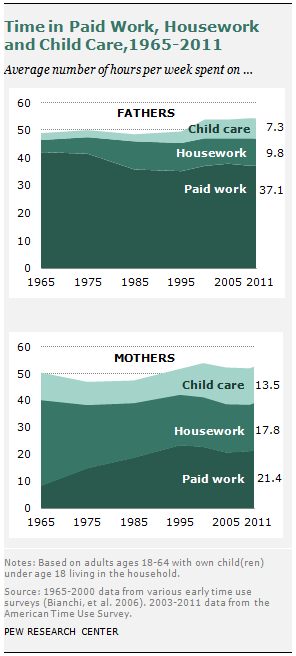
The work lives of American men and women have become more similar since the 1960s, measured by time in both paid work for a job and unpaid work at home. The average hours spent per week at job-related activities has declined from 42 hours in 1965 to 37 hours in 2011 for fathers, but increased from eight hours to 21 hours for mothers.15
On the home front, fathers today spend more than twice as much time doing housework as they did in the 1960s (10 hours vs. four hours per week), and mothers have cut their housework time almost in half during the same period (18 hours vs. 32 hours per week). These analyses are based on historical time diary data16 as well the more recent American Time Use Survey, which asked nationally representative samples of Americans about activities they did in the previous day sequentially.
Parents’ time with their children continues to go up. Fathers have nearly tripled their time with their children (from 2.5 hours in 1965 to 7.3 hours per week in 2011). After a decline in the 1970s and ’80s, mothers’ time with their children has also increased, and today’s mothers spend more time with their children than mothers did in the 1960s. Despite the increase in child care time among fathers, American mothers spend about twice as much time with their children as fathers do.17 In 2011, the average child care time is 7.3 hours per week for fathers and 13.5 hours per week for mothers.
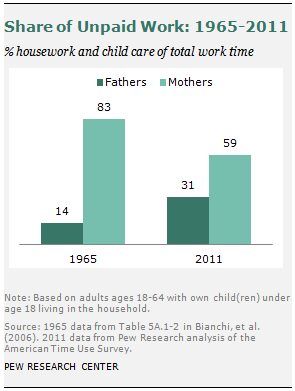
The total work time for parents, which includes both paid and unpaid (housework and child care) work, has increased slightly over more than four decades, and the total workload for mothers and fathers has been nearly identical. In 1965, fathers spent about 49 hours per week in paid work, housework and child care combined, compared with 54 hours in 2011. Mothers’ total work time was 51 hours in 1965 and 53 hours in 2011.
What has changed more over this period is the allocation of time. More than 80% of mothers’ work time in 1965 was spent taking care of the house and caring for children; that share dropped to about 60% by 2011. In contrast, more of fathers’ time is now spent in unpaid work; the share of work time fathers devote to housework and caring for children has increased from 14% to 31%.
Work and Leisure Time among Parents in Different Types of Families
American families have undergone dramatic changes in the past five decades, as the share of adults who are married has declined from 72% in 1960 to about 50% today.18 Compared with single fathers and fathers who live with a partner, married fathers work longer hours in their job and have the least amount of leisure time. Married mothers, meanwhile, spend more time in housework than do single or cohabiting mothers, but they also have the least amount of leisure time. As a result, married parents spend more time at work than unmarried parents, counting housework, child care and paid work together, and have less leisure time than other parents.
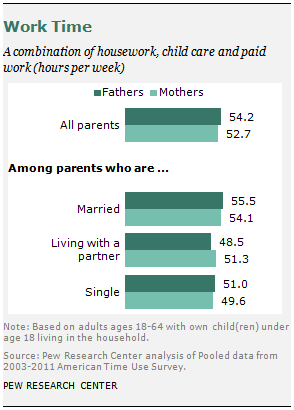
On average, married fathers’ overall weekly workloads are 1.4 hours more than those of married mothers, while the workload for cohabiting fathers is almost three hours less than that of cohabiting mothers. Single fathers’ overall work time is slightly longer than that of single mothers (51 hours per week vs. 50 hours). Regardless of their family arrangements, fathers in general have more leisure time than mothers.
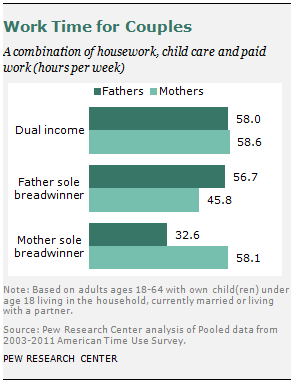
The gender gap in work and leisure is more closely related to how couples arrange their paid and unpaid work. Among parents who are married or living with a partner, dual-income couples are the most egalitarian couples, even though they do not divide up their work in a 50-50 way. Dual-income fathers spend about 11 hours more than mothers in paid work per week, but mothers make up their hours by spending more time on average time in child care and housework. Dual-income fathers have more leisure time than mothers; the gap is about 4.5 hours per week.
Time in work and leisure is somewhat unbalanced among single-income families, especially when the mother is the breadwinner. Working mothers are overburdened in this arrangement: They spend about 25 hours more in total work time per week, but 20 hours less in leisure, than their non-employed partners do. In contrast, when working fathers are the sole breadwinner, their overall work time is about 11 hours per week more than their non-employed partner’s, and their leisure time is about four hours less than their partners’ leisure time.
How Do Parents Feel about their Time?
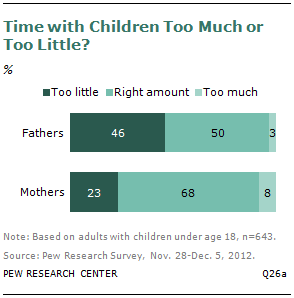
Findings from the time diary data are largely echoed by how parents feel about their time in a recent Pew Research Center survey. About half of adults with children under age 18 (49%) say that they spend more time with their children than their parents did when they were young. One-third say that their own child care time is the same as their parents’. This is consistent with the rising child care time for parents since the 1960s based on the time use data.
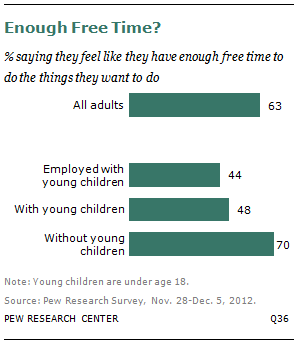
Given that American fathers’ time with children is only about half of mothers’, it is not surprising to find that American fathers with children under age 18 are twice as likely as mothers to say they don’t spend enough time with their children. According to a recent Pew Research survey, 46% of fathers say they spend too little time with their children, compared with 23% of mothers. A majority of mothers (68%) say they spend the right amount of time with their children, compared with only half of fathers.
When it comes to “who does more” child care as well as household chores and responsibilities among married or cohabiting parents, both mothers and fathers indicate that mothers usually do more—although a higher share of fathers report that these responsibilities are shared equally.
Even though findings from the time use data suggest that generally men spend more time than women in leisure activities, there is no significant gender difference in how adults view their free time. Among parents with children under age 18, 48% say that they generally feel like they have enough free time to do the things they want to do. The share falls to 44% among working parents with young children. In contrast, a vast majority of parents without young children (70%) report that they have enough free time, in part because a higher share of these adults are retired.
The rest of this section goes into details about the long-term trend of Americans’ time at work and at home as well as time use patterns among parents of different family types and living arrangements. Public opinion questions related to time use are also discussed when available.




